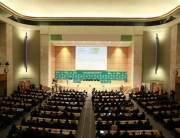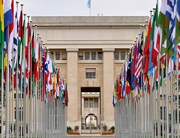Project Description
The remarks of Andrea Saldarriaga, co-Lead of the LSE Investment & Human Rights Project, an initiative of the Laboratory for Advanced Research on the Global Economy in the Centre for the Study of Human Rights
European Commission
Directorate-General for Financial Stability, Financial Services and Capital Markets Union on the
“Treatment of EU investors in the Single Market”
Seminar
– Do we need a new policy instrument?
19 June 2015
 Thank you to the Directorate-General for the invitation to speak to you today. I would like to share with you some reflections on the questions raised in the programme for this meeting based on my many years litigating investment cases and my later involvement with policy issues and the business and human rights agenda.
Thank you to the Directorate-General for the invitation to speak to you today. I would like to share with you some reflections on the questions raised in the programme for this meeting based on my many years litigating investment cases and my later involvement with policy issues and the business and human rights agenda.
I will then address the two questions set out for this panel discussion. First, do we need a new policy instrument? Second, whose rights to protect? In addressing these questions I will describe the connection between these two questions and give some ideas for a way forward. Maybe you will think my ideas are quite optimistic, but at the very least I will provoke further questions!
Do we need a new policy instrument? To answer this question we need to start by asking a new policy instrument for what?
We must first separate the policy objectives from the instruments or tools to attain those objectives. In this case the tool or instruments under consideration are investment treaties.
But let’s go back to the policy objectives. At the policy level, do we have a consensus around what role investment plays? Is it an end in itself? Or is there a need to ensure that investment supports larger policy objectives? The OECD, in its recent revision of its Policy Framework for Investment (PFI) says that we need to stop thinking of investment as an end in itself because large flows of investment do not necessarily translate into growth and more jobs. And without the proper safeguards, these flows might even cause negative impacts on people and the environment.
So do we agree that investment is not an end in itself? If so, we need to create policies, rules and practices that harness investment to ensure that it supports our larger policy objectives. This should mean that investment should be harnessed to achieve our environmental, social and economic goals, while reinforcing principles of good governance – that is, make sure that investment supports the values that we now identify as sustainable development.
This is particularly true in the European context where the Lisbon treaty clearly expresses that
The Union is founded on the values of respect for human dignity, liberty, democracy, equality, the rule of law and respect for human rights.
The need to ensure investment supports sustainable development has already been expressed by the European Parliament, by international organisations like UNCTAD and more recently, expressly stated in the OECD PFI. But this consensus, if it exists, must be reinforced by European institutions and policies. There is much to be done here.
However, assuming for a moment that we all want investment to support sustainable development, we can then turn to the question on the instruments: are investment treaties, as we know them today, the right instruments to attain this goal?
I believe they are not.
The structure and substance of these treaties largely embody the values of a time when the dominant world view was that international investment necessarily resulted in economic growth, that economic growth alone secured development, and that corporations had no other purpose but that of making profits. These values are not aligned to what we now know to be true about achieving sustainable development.
If we have a shared understanding that international investment should support sustainable development, how should these instruments change shape? Is it possible for them to embody values that underpin sustainable development and remain similar to what we know today? Or do we need an entirely new design?
This is where I feel that we should not be scared to think outside the box – to think outside the current structure of treaties and dare to rethink their fundamentals. To illustrate what I mean I propose we reflect on the very notion of protection embodied in the treaties. And this takes me also to the second question I want to address: whose rights to protect?
IIAs promote investment by protecting against the single threat of host-State interference. And in the 1950s, when the treaties were first conceived, this was in fact the prominent concern for investors. But we know that today investors face other type of risks including in particular risks associated with stakeholder challenges and resistance to company operations. These challenges are typically grounded on environmental and human rights concerns.
To give you an example, a study used by John Ruggie – the former Special Representative on BHR – indicated how of 190 projects operated by international oil majors “the time for new projects to come on stream has nearly doubled in the past decade, causing significant cost inflation” and that the major factor in these delays was “stakeholder-related risks.”
And this is not a problem of developing countries only. It suffices to look at the “no TAV” movement in Italy against a new high-speed train rail or the recent decision of the Scottish government on the moratorium on all planning consents for unconventional oil and gas extraction.
So protecting an investment today is as much about avoiding undue government interference as it is about managing social and environmental risks and the relationship with those people impacted by the investment.  From this perspective, the question of whose rights to protect does not actually represent a dichotomy – it is not whether we protect the investor or we protect people and the environment. Rather it is about how, by protecting people and the environment, can we help guarantee the viability and success of the investment, and even its access to the financial markets.
From this perspective, the question of whose rights to protect does not actually represent a dichotomy – it is not whether we protect the investor or we protect people and the environment. Rather it is about how, by protecting people and the environment, can we help guarantee the viability and success of the investment, and even its access to the financial markets.
Following this line of argument, investors’ responsibilities – in particular with respect to human rights and the environment – should not be seen as a burden but as a risk management tool and should be an integral part of the architecture of the regulation of investment, being reflected even in how we formulate guarantees for investors.
Yesterday, in the OECD Global Forum on Responsible Business Conduct Richard Howitt, the European Parliament Rapporteur on Corporate Social Responsibility (CSR), expressed his concerned about TTIP, the Transatlantic Trade and Investment Partnership (TTIP). He described how 12,000 people in his constituency have contacted him to protest against the treaty with the generalised perception that treaties protect investors at the expense of people, the environment and human rights. He said that unless we solve this conundrum between protecting investors on the one hand and protecting people and the environment on the other, the treaty would fail.
What I argue is that the conundrum is part of the current architecture of the treaties and that we need to look beyond the boundaries of the treaties we know today and dare to challenge treaty fundamentals to solve this conundrum.
In contrast, some of the ideas raised in the recent discussions on international investment agreements (IIAs) that suggest including some references to CSR and human rights in the preambles of the treaties, or some adjustments in the language of Fair and Equitable Treatment are far from sufficient if our policy objectives and our ideas on fundamental concepts such as ‘protection’ have shifted.
So what is next? And what is in it for the intra EU BITs?
There appears to be political urgency in light of the current negotiations for TTIP and the manifest incompatibilities between IIAs and EU law. However, is it wise to rush a partial solution that actually leaves little changed from the treaties we drafted 60 years ago? Whatever language gets agreed will still have to be ratified by all the parliaments of the 28 member states, and half measures in the treaty may lead to stagnation in domestic contexts. Perhaps it is not a bad idea now to focus on building a strong consensus in the EU around the policy objectives of investment, including within the Single Market.
The questions on intra-EU BITs and the debate around TTIP offer a unique opportunity to define a European investment policy that reflects the sophistication of European societies and institutions, while at the same time recognising the needs and specificities of its members.
The definition of this policy must also reflect the European values of transparency, democracy and participation. It should therefore include a multi-stake holder process that informs the construction of this policy by understanding the needs of states, the needs of investors and the expectations of societies – and this in the context of the Single Market.
This process should be accompanied by a thoughtful reflection over the fundamentals of the system of investment protection including the notions of protection and investors’ responsibilities. This reflection should begin with an understanding of the existing regulation of investment in the member states to identify common principles, existing gaps and the challenges that need to be addressed.
Thank you.
Prepared Text—Check Against Delivery
Photo credits
European flags outside European Commission: source theyucatantimes.com
Rice fields: source Shutterstock











